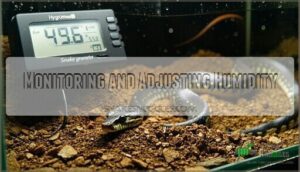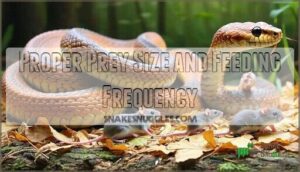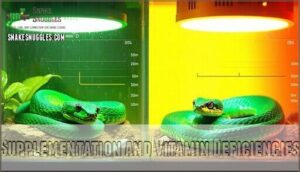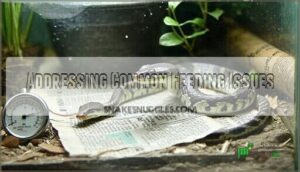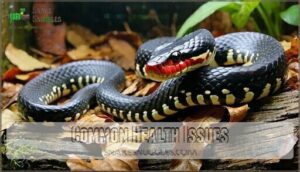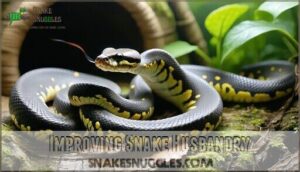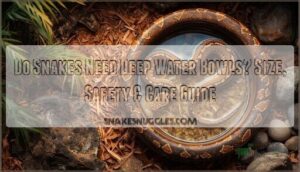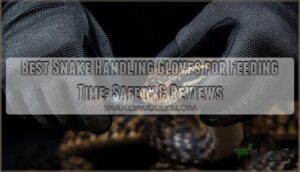This site is supported by our readers. We may earn a commission, at no cost to you, if you purchase through links.
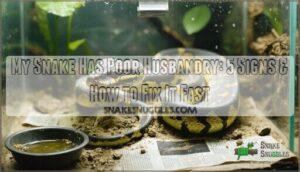
Common red flags include excessive hiding, meal refusal, aggressive behavior, breathing difficulties, stuck shed, or unusual lethargy.
These issues typically stem from incorrect temperatures, wrong humidity levels, poor substrate choices, or improper feeding schedules.
Most problems can be fixed by adjusting your enclosure’s temperature gradient, maintaining proper humidity, choosing appropriate substrate, and following species-specific feeding guidelines.
Some situations may need veterinary attention if health complications have already developed, and the key is addressing these issues systematically rather than making drastic changes all at once, to ensure the best outcome for your snake’s health complications and overall well-being, by following a species-specific approach and maintaining a suitable temperature gradient.
Table Of Contents
- Key Takeaways
- Recognizing Poor Husbandry
- Essential Enclosure Setup
- Nutrition and Feeding Practices
- Common Health Issues
- Improving Snake Husbandry
- Frequently Asked Questions (FAQs)
- Why are snakes low maintenance?
- How do I know if my snake is malnourished?
- Why is my snake struggling to shed?
- What does husbandry mean in snakes?
- What is the best husbandry for a ball python?
- What are signs of stress in snakes due to poor husbandry?
- How often should snake enclosures be cleaned and disinfected thoroughly?
- Can scale rot in snakes be fatal if left untreated?
- What is the ideal humidity level for most pet snake species?
- How can I prevent regurgitation and vomiting in my pet snake?
- Conclusion
Key Takeaways
- Watch for clear warning signs – Your snake’s excessive hiding, meal refusal, aggressive behavior, breathing issues, stuck shed, or lethargy indicate husbandry problems that need immediate attention.
- Fix environmental basics systematically – You’ll need to establish proper temperature gradients (warm and cool zones), maintain species-specific humidity levels (50-80%), and choose an appropriate substrate rather than making drastic changes all at once.
- Address feeding and nutrition properly – You should feed prey that’s roughly the same width as your snake’s thickest body part, follow species-specific feeding schedules, and ensure you’re providing complete nutrition through whole prey items.
- Make gradual improvements with professional help – You’ll get better results by adjusting the temperature by 2-3°F weekly, increasing humidity by 10% increments, and consulting reptile veterinarians for persistent health issues rather than rushing the process.
Recognizing Poor Husbandry
Poor husbandry in snakes often shows up as subtle changes that you might miss if you’re not watching closely.
Your snake’s behavior, physical condition, and overall well-being can quickly deteriorate when basic care requirements aren’t met properly, which can be a result of poor husbandry.
Common Signs of Inadequate Care
Poor snake husbandry shows up in several unmistakable ways that’ll make your heart sink.
These snake husbandry issues often stem from reptile care mistakes that create serious snake health problems.
Watch for these telltale signs of improper snake habitat and poor enclosure setup:
- Dull Eyes and Abnormal Shedding – Cloudy, lifeless eyes paired with patchy, incomplete sheds signal environmental problems
- Weight Fluctuations and Lethargic Behavior – Rapid weight loss or gain combined with unusual inactivity indicates stress
- Poor Droppings – Watery, discolored, or foul-smelling waste reveals digestive issues from inadequate care.
Inadequate ventilation can lead to respiratory health problems.
Behavioral Changes Indicating Stress
Your snake’s behavior tells a story about its well-being. Watch for excessive hiding beyond normal secretive tendencies, as stressed snakes often retreat completely from their environment.
Glass surfing—repeatedly moving along enclosure walls—signals discomfort with temperature or humidity levels. Erratic movements, constant restlessness, or apathy displayed through complete inactivity are red flags.
Monitor for regurgitation signs following meals, which indicates severe stress requiring immediate attention.
Physical Symptoms of Poor Health
How can you tell if your snake’s health is declining? Your pet’s physical appearance often provides the clearest warning signs of underlying problems.
- Cloudy Eyes – Beyond normal pre-shed milkiness, persistent cloudiness signals infections or mites affecting snake eye health
- Abnormal Droppings – Loose stools, blood, or unusual colors indicate digestive issues requiring immediate attention
- Scale Issues – Dull, rough, or missing scales reveal poor snake skin condition and potential infections
- Weight Changes – Rapid loss or gain suggests parasites, organ problems, or improper feeding schedules
- Lethargy – Lethargic snake behavior includes excessive hiding, lack of movement, or constant soaking in water dishes
The signs of declining health in snakes can be identified through various physical and behavioral changes, including those listed above.
Environmental Red Flags in Snake Enclosures
Your snake’s home might be sending distress signals you’re missing.
Temperature extremes without proper gradients create dangerous hotspots or cold zones.
Humidity imbalances—too dry or soggy—stress your snake’s respiratory system and shedding cycles.
Unhygienic conditions with accumulated waste breed bacteria and parasites.
Inadequate hiding spots leave snakes feeling exposed and anxious.
Lighting issues, like constant brightness or complete darkness, disrupt natural behaviors and stress levels, creating an environment that is not natural.
Essential Enclosure Setup
Your snake’s enclosure is its entire world, and getting the basics right can mean the difference between a thriving pet and ongoing health problems.
Let’s fix the temperature, humidity, and heating setup to create the perfect environment your snake needs to stay healthy.
Importance of Temperature Gradients
Temperature gradients aren’t just nice-to-have features in snake enclosures—they’re lifelines for your reptile’s health.
Your snake needs different temperatures throughout its habitat to regulate body functions properly. Without proper gradient creation, you’re basically asking your pet to survive in a one-size-fits-all environment that doesn’t work.
Here’s what ideal thermoregulation provides:
- Digestive Efficiency – Warmer spots aid food processing and nutrient absorption
- Immune Response – Temperature variation supports disease resistance and healing
- Species Variation – Different snakes require specific thermal ranges for survival
- Stable Environment – Consistent gradients prevent stress and behavioral issues.
Snake temperature regulation depends on accessing both warm and cool zones within their enclosure.
Providing adequate heat is vital, often achieved with a quality reptile lamp.
Inadequate temperature gradients force snakes into constant discomfort, leading to poor appetite, sluggish behavior, and compromised health.
Snake enclosure conditions directly impact every aspect of your pet’s wellbeing.
Selecting Appropriate Heating Equipment
Once you’ve established proper temperature gradients, choosing the right heating equipment becomes your next priority.
Your snake’s health depends on matching heat source types to your specific setup and species needs.
| Heat Source Types | Best For |
|---|---|
| Under tank heaters (UTH) | Small enclosures, belly heat |
| Ceramic heat emitters | Nocturnal species, ambient warmth |
| Radiant heat panels | Large wooden enclosures |
| Heat tape | Custom builds, rack systems |
| Deep heat projectors | Tall enclosures, natural heating |
Thermostat control prevents dangerous overheating that causes burns.
Temperature monitoring with digital thermometers guarantees your snake temperature regulation stays within safe ranges.
Calculate wattage based on enclosure size – typically 5-10 watts per square foot prevents inadequate temperature gradient issues while maintaining proper snake enclosure conditions.
Reptiles require external heat sources to regulate their body temperature.
Monitoring and Adjusting Humidity
Getting your snake’s humidity right isn’t guesswork—it’s about using the right tools. A digital hygrometer beats analog every time for accurate humidity measurement.
Place it halfway up your enclosure wall, away from water bowls. When humidity levels are wrong, you’ll see incomplete sheds and stressed behavior.
Adjust through daily misting frequency and moisture-retentive substrates. Monitor shedding success as your best indicator of proper snake humidity control.
Understanding reptile enclosure monitoring is vital for maintaining ideal conditions.
Creating Microclimates Within The Enclosure
Beyond maintaining proper humidity levels, you’ll want to create distinct Temperature Zones throughout your snake’s enclosure.
Think of it like designing a studio apartment – every corner serves a purpose for your scaly roommate’s comfort.
Your snake habitat setup should include:
- Basking Spots with warmer temperatures for digestion
- Cool Hiding Places for stress-free retreats
- Substrate Choice that maintains Humidity Gradients
- Multiple snake environment zones matching snake habitat requirements
This microclimate approach gives your snake options to self-regulate, promoting natural behaviors and ideal snake humidity control.
Nutrition and Feeding Practices
Poor nutrition often stems from incorrect feeding schedules, wrong prey sizes, or inadequate environmental conditions that affect your snake’s appetite.
Understanding your snake’s specific dietary needs and creating proper feeding routines will address most nutrition-related health problems quickly, which can be achieved by following a well-planned feeding schedule.
Species-Specific Dietary Requirements
Your snake’s nutritional needs vary dramatically by species, making one-size-fits-all feeding approaches dangerous.
Ball pythons thrive on rodents, while garter snakes need fish and amphibians.
Understanding your snake’s natural diet prevents malnutrition and supports healthy feeding schedules.
Proper prey variety guarantees balanced nutrition without supplementation risks.
| Snake Species | Primary Prey | Feeding Notes |
|---|---|---|
| Ball Python | Mice, rats | Whole prey provides complete nutrition |
| Corn Snake | Rodents, birds | Variety prevents nutritional deficiencies |
| Garter Snake | Fish, amphibians | Requires thiamine supplementation with fish |
| King Snake | Rodents, reptiles | May cannibalize other snakes |
The table provides a summary of the primary prey and feeding notes for different snake species, highlighting the importance of complete nutrition for each species.
Proper Prey Size and Feeding Frequency
Feed your snake prey that’s roughly the same width as the thickest part of your snake’s body.
Adult corn snakes typically need one small rat every 7-14 days, while juveniles require more frequent meals.
Overfeeding leads to obesity and regurgitation risks, so stick to a consistent feeding schedule.
Understanding appropriate prey options is vital for snake health.
Your snake’s feeding habits will vary by species, but most adults eat every 1-2 weeks with appropriate prey weight for superior snake nutrition.
Supplementation and Vitamin Deficiencies
Without proper supplementation, your snake’s health can suffer from vitamin deficiency snake symptoms like eye swelling and neurological issues.
Calcium absorption requires adequate Vitamin D3 levels, while supplement types include calcium powder and multivitamins.
Nutritional deficiencies manifest as lethargy, poor growth, and respiratory infections.
However, over-supplementation poses risks too—balance is key for ideal snake nutrition and meeting dietary needs, and ensuring the right level of supplementation is crucial.
Addressing Common Feeding Issues
Appetite troubles happen to every snake owner at some point.
Your snake’s refusal reasons might include seasonal changes, upcoming sheds, or simple prey preference shifts.
Proper defrosting methods guarantee food safety—never use microwaves or hot water.
Adjust feeding frequency based on your snake’s age and size.
Most snake feeding problems stem from husbandry issues rather than supplementation needs, so focus on environment first, considering proper defrosting.
Common Health Issues
Poor husbandry creates a cascade of health problems that can quickly turn serious if left unchecked.
You’ll notice these issues manifest in predictable patterns, from respiratory infections caused by improper temperatures to parasitic infestations from unsanitary conditions, which can lead to a cascade of issues if not addressed properly with proper care.
Respiratory Infections and Scale Rot
Poor feeding habits often lead to weakened immune systems, making your snake vulnerable to respiratory infections and scale rot.
Bacterial causes dominate these conditions, while fungal infections thrive in damp environments, creating perfect breeding grounds for pathogens through wrong humidity levels.
Scale rot snake symptoms include discolored ventral scales and foul odors, while snake respiratory infection signs include labored breathing and nasal discharge.
Antibiotic use requires veterinary guidance, but preventative measures through proper snake husbandry and correct habitat conditions remain your best defense.
Parasitic Infestations and Their Prevention
Behind every healthy snake lies proper parasite prevention, yet up to 73.6% of examined snakes harbor gastrointestinal parasites.
Mite identification starts with spotting tiny moving dots on your snake’s skin, while internal parasites require fecal testing.
Snake parasite infection spreads through contaminated prey and poor hygiene practices.
Implement quarantine protocols for new snakes and maintain strict hygiene practices to prevent the spread of parasites.
Preventative treatments include regular veterinary checkups and immediate fecal removal to break transmission cycles.
Metabolic Bone Disease and Nutritional Deficiencies
Nutritional problems can silently undermine your snake’s health long before you notice physical symptoms. Calcium Deficiency weakens bone structure, while inadequate Vitamin D3 prevents proper calcium absorption, creating a dangerous cycle that compromises snake health.
Here are four key nutritional concerns affecting snake disease prevention:
- Supplementation Risks – Over-supplementing can be as harmful as deficiency, causing kidney problems and metabolic imbalances
- Dietary Diversity – Feeding only one prey type limits essential nutrients needed for ideal snake nutritional health
- Prey Quality – Frozen prey loses nutritional value over time, affecting your snake’s overall wellness
- Feeding Frequency – Irregular feeding schedules disrupt metabolic processes and nutrient absorption
Monitor your snake’s bone density through gentle handling – soft or bendable ribs indicate serious deficiency requiring immediate snake veterinary care. Radiographs can help reveal bone density changes if MBD is suspected.
Shedding Problems and Stuck Eyecaps
Shedding frequency varies by species, but dysecdysis signals trouble.
When humidity levels drop below ideal ranges, your snake can’t complete its natural snake shedding cycle properly.
Retained spectacles are the most dangerous complication—these stuck snake eye caps can cause permanent blindness.
You’ll notice patchy, incomplete snake shedding problems instead of one clean piece.
Preventative measures include maintaining proper humidity and providing rough surfaces.
However, persistent issues require veterinary intervention to prevent serious complications.
Improving Snake Husbandry
Now that you’ve identified the warning signs, it’s time to turn things around for your snake’s wellbeing.
Making targeted improvements to your snake’s care doesn’t have to be overwhelming if you approach it systematically and track your progress along the way.
This approach will help ensure that you’re making progress in improving your snake’s care.
Gradual Implementation of Changes
When making husbandry changes, should you rush the process? Absolutely not. Stress reduction requires patience and minimal disruption to your snake’s established routine.
Gradual adjustments prevent overwhelming your pet during improvements. Routine changes demand patience required for successful snake care improvements.
- Temperature Changes – Adjust heating by 2-3°F weekly until reaching ideal ranges
- Humidity Modifications – Increase or decrease humidity levels by 10% increments biweekly
- Substrate Replacement – Mix old and new bedding materials for familiar scents
- Lighting Adjustments – Modify photoperiods by 30-minute intervals over several weeks
- Enclosure Upgrades – Introduce new décor gradually while maintaining familiar hiding spots
Monitoring and Recording Snake Behavior
After implementing changes, tracking your snake’s daily patterns becomes essential for success.
Keep a simple log noting activity patterns, eating habits, and shedding frequency.
Watch how your snake uses its enclosure – does it prefer certain hiding spots or basking areas?
Document feeding responses and any behavioral shifts.
This snake behavior monitoring helps you spot improvements in snake activity levels and overall snake health monitoring, ensuring your adjustments work effectively, which is crucial for the overall snake health.
Consulting With Reptile Veterinarians
Professional snake veterinary consultation becomes your next step after tracking behavioral patterns. Reptile vets bring specialized care and diagnostic options that general veterinarians might miss.
These experts develop thorough treatment plans while emphasizing preventative medicine for long-term health success. A vet can also provide guidance on proper snake nutrition for ideal health.
- Vet Expertise – Reptile veterinarians receive specialized training in exotic animal medicine, improving diagnostic accuracy for snake-specific conditions
- Advanced Diagnostic Options – X-rays, blood panels, and fecal analysis detect subclinical diseases before symptoms become severe
- Customized Treatment Plans – Professional assessments create individualized care strategies based on your snake’s species and observed deficiencies
- Preventative Medicine Focus – Annual snake veterinary checkups catch early disease signs while routine screenings prevent parasitic outbreaks
- Ongoing Support – Veterinary care includes owner education on recognizing illness signs and refining husbandry practices through telemedicine access
Ongoing Education in Snake Care
Snake owner education doesn’t stop after your initial setup improvements.
Advanced Husbandry techniques, Emerging Diseases, and Ethical Considerations in snake care constantly evolve.
Join online communities, attend reptile shows, and follow veterinary research to stay current.
Behavioral Enrichment methods and Conservation Efforts provide fresh perspectives on improving snake care.
Continuous learning guarantees your snake care best practices remain cutting-edge.
Frequently Asked Questions (FAQs)
Why are snakes low maintenance?
You’ll find snakes surprisingly low-maintenance because they don’t need daily feeding, complex social interaction, or constant attention.
They eat infrequently, require minimal space, and thrive with proper temperature and humidity settings, which makes them easy to care for with proper settings.
How do I know if my snake is malnourished?
Don’t assume subtle signs mean nothing’s wrong.
Check for prominent ribs, spine visibility, rapid weight loss, consistent food refusal, lethargy, dull scales, and sunken eyes—these indicate malnutrition requiring immediate veterinary attention.
Why is my snake struggling to shed?
Poor humidity levels and incorrect temperatures are typically behind difficult shedding.
You’ll need to boost humidity to 60-80% and maintain proper heat gradients.
Low temperatures slow the process, while inadequate moisture makes skin stick stubbornly, requiring adjustments to achieve proper humidity levels.
What does husbandry mean in snakes?
Husbandry means caring for your snake’s environment and needs.
You’ll manage temperature, humidity, lighting, housing, feeding schedules, and cleanliness.
It’s the complete care package that keeps your snake healthy and happy.
What is the best husbandry for a ball python?
Ball pythons need 88-92°F warm side, 78-80°F cool side, 50-60% humidity, secure hides on both ends, water bowl, cypress mulch substrate, and proper lighting cycles for peak health.
What are signs of stress in snakes due to poor husbandry?
Watch for excessive hiding, constant soaking, lethargy, or irregular activity patterns.
Your snake might refuse food, show labored breathing, or display abnormal shedding.
These behaviors often signal temperature, humidity, or environmental stress issues, which can be indicated by lethargy.
How often should snake enclosures be cleaned and disinfected thoroughly?
Absolutely spotless cages aren’t just nice—they’re lifesavers!
You’ll need thorough cleaning and disinfection weekly, especially since snakes naturally carry Salmonella bacteria.
Weekly cage disinfection prevents disease transmission and maintains your snake’s health.
Can scale rot in snakes be fatal if left untreated?
Yes, scale rot can be fatal if left untreated.
This bacterial infection spreads deeper into tissues, potentially causing septicemia and organ failure.
You’ll need immediate veterinary care and improved husbandry to prevent serious complications.
What is the ideal humidity level for most pet snake species?
Most pet snakes thrive with humidity levels between 50-60%, though species vary.
Ball pythons need 60-80%, while corn snakes prefer 40-50%.
You’ll want to monitor with a hygrometer and adjust based on your snake’s specific needs.
How can I prevent regurgitation and vomiting in my pet snake?
Prevention is your best defense against regurgitation—maintain proper temperatures, avoid handling after feeding, make certain appropriate prey size, and don’t rush feeding schedules. Wait 48-72 hours between meals.
Conclusion
Studies show that 70% of captive reptile health issues stem from improper husbandry rather than disease.
Recognizing that my snake has poor husbandry isn’t failure—it’s awareness that leads to better care.
By systematically addressing temperature gradients, humidity levels, substrate choices, and feeding schedules, you’ll create an environment where your snake can thrive.
Remember, gradual changes work better than drastic overhauls.
Monitor your snake’s response to improvements, and don’t hesitate to consult reptile veterinarians when needed. Proper husbandry transforms stressed snakes into healthy, active companions.
- http://www.reptile-database.org
- https://community.morphmarket.com/t/recommended-heat-mat/45796
- https://talis-us.com/blogs/news/types-of-heat-bulbs-for-snakes
- https://www.snakehaus.com/frontpage/education/climate-control/
- https://www.reddit.com/r/snakes/comments/cpjb73/heat_lamps_vs_heat_mats_for_ball_pythons/



